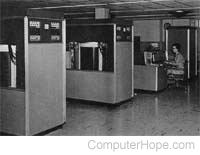Computer data storage history
Below are major historical events that have helped develop computer data storage into what it's today. This page includes developing storage devices like hard drive, diskette drives, optical disc drives, and other storage mediums.
See our Computer hard drive history for history events only relating to computer hard drives.
1725
In Lyon, France, Basile Bouchon invented a loom in 1725 that used a perforated paper tape roll that was later upgraded in 1728 by his assistant Jean-Baptiste Falcon to use punch cards. Although this loom predates the Jacquard Loom, it was not fully automated.
1804
Frances Joseph-Marie Jacquard completed his fully automated loom in 1804 programmed by punched cards.
1832
Semen Korsakov used punch cards for the first time in 1832 to store and search for information.
1890

Herman Hollerith developed a method for machines to record and store information onto punch cards for the US census. He later formed the company we know as IBM today.
1946
Freddie Williams applied for a patent on his CRT (cathode ray tube) storage device in December (later known as the Williams tube). It could store between 512 and 1024 bits of data.
1956

IBM released the first hard drive (IBM 350 Disk File) on September 13, 1956. It is a non-removable device, with a 5 MB storage capacity and cost $50,000. The hard drive was first used in the IBM 305 RAMAC (random-access method of accounting and control) system.
1963
IBM developed the first removable hard drive, having a capacity of 2.6 MB.
1966
James Russell invented the concept of a CD (compact disc) in 1966. He was granted a patent for the CD in 1970.
1967
IBM began developing floppy disk technology in 1967 at its San Jose, California site.
1971
The first floppy disk device, the IBM 23FD, and the first floppy disk was released by IBM in 1971. The floppy disk was 8 inches in diameter, had a storage capacity of 80 KB, and was read-only. The 23FD was a built-in component of the 2835 Storage Control Unit.
1972
Memorex released a floppy disk drive called the Memorex 650 in 1972. The 650 floppy diskette stored 175 KB of data and was used by many devices.
1976
Shugart Associates released the first 5.25-inch floppy disk drive in 1976. The 5.25-inch single-density floppy disk initially had a capacity of 90 KB. The double-density floppy disk held an initial 113 KB. Other companies later increased disk capacity.
Dataram Corporation released BULK CORE, the world's first SSD (solid-state drive) storage technology, for DEC (Digital Equipment Corporation) and Data General computers.
1980
The first 1 GB (gigabyte) hard drive was developed by IBM, weighing 550 pounds and costing $40,000.
1981
Sony introduced its first 3.5-inch floppy disk drive in 1981. The 3.5-inch floppy disk had a formatted capacity of 161.2 KB. However, the MIC (Microfloppy Industry Committee) released a 3.5-inch media specification in 1982 that rendered Sony's 3.5-inch floppy disk and drive unusable.
1982

The first CD (compact disc) was developed by Philips and Sony on August 17, 1982.
1983
Rodime developed the first 3.5-inch hard drive with a capacity of 10 MB.
The first single-sided 3.5-inch floppy disk drives, adhering to the MIC specifications, were released in 1983. Double-sided 3.5-inch floppy disk drives were released in 1984.
1988
Philips and Sony published the specifications for CD-R (compact disc recordable) technology. The technology was initially named CD-WO (compact disc write once) or WORM (write once read many).
Digipro, a small PC (personal computer) vendor in Alabama, USA, revealed the first SSD prototype built using flash memory. It featured Intel's NOR flash memory technology released earlier in the same year.
1990
The CD-R (recordable CD) technology with the ability to write data to a CD was available on the market starting in 1990. The first devices were nearly the size of a washing machine and cost around $35,000.
1991
SanDisk brought the first consumer SSD to market, featuring a capacity of 20 MB.
1994

Iomega introduced the Zip drive in 1994. The first zip disk had a capacity of 100 MB. Later zip disks have capacities of 250 MB and 750 MB.
The CompactFlash flash memory card was developed and released by SanDisk in 1994. The first CompactFlash cards have a storage capacity of 2 MB.
1995
The DVD (digital versatile disc) was invented and developed by multiple companies in 1995. Companies involved in the DVD development include Hitachi, JVC, Matsushita Electric, Mitsubishi Electric, Philips, Pioneer, Sony, Time Warner, and Toshiba.
1996
Hewlett-Packard announced it would no longer be manufacturing hard drives, July 10, 1996.
1997
Imation developed the SuperDisk drive and diskette, also called the LS-120. The first SuperDisk diskette had a capacity of 120 MB, with a later version having a capacity of 240 MB.
The rewritable CD, or CD-RW (compact disc re-writable), was introduced in 1997. It allows data to be written to a specific type of rewritable disc again and again.
The DVD-R (digital versatile disc recordable) and DVD-RW (digital versatile disc read/write) discs were developed by Pioneer in 1997.
The DVD+R and DVD+RW disc format, a recordable DVD that utilized the "+" format, was created by the DVD+RW Alliance in 1997. The alliance includes Dell, HP (Hewlett-Packard), Ricoh, Sony, and Yamaha.
The MMC (MultiMediaCard) was a flash-based memory card developed by SanDisk and Siemens in 1997.
1998
The Memory Stick was released by Sony in October 1998. The Sony Memory Stick is a memory card that can only be used with Sony devices.
1999
Amir Ban, Dov Moran, and Oron Ogdan at M-Systems, now SanDisk, developed the first USB flash drive, called a DiskOnKey, in April 1999. It had a storage of capacity of 8 MB and was sold to the public starting in 2000.
Panasonic, SanDisk, and Toshiba developed the SD (Secure Digital) memory card format and introduced it to the public in August 1999.
2006
The Blu-ray disc format was developed by multiple companies and introduced to the public on January 4, 2006. Companies involved include Dell, Hitachi, Hewlett-Packard, LG, Mitsubishi, Panasonic, Sony, and TDK. The Blu-ray format was a competing high definition data technology to HD DVD. A Blu-ray disc can store 25 GB or 50 GB of data, depending on if it's a single-layer or dual-layer disc.
Toshiba released the first HD DVD player on March 31, 2006. The HD DVD format was a competing high definition data technology to Blu-ray. An HD DVD can store 25 GB of data per layer. Blu-ray beat out HD DVD in the high definition disc technology war on February 19, 2008.
Samsung released the first Blu-ray player in June 2006.
The first Blu-ray rewritable drive available to the mass market was released by Sony, the BWU-100A. It retailed for $699 and was capable of writing data to single-layer and dual-layer Blu-ray discs.
2007
The first 1 TB (terabyte) hard drive, developed by Hitachi, was released in January 2007.
MIT (Massachusetts Institute of Technology) student Drew Houston, frustrated by forgetting his USB (universal serial bus) drive before getting on a train from Boston to New York, conceived of the Dropbox cloud data storage service. In June 2007, he founded Dropbox, Inc. Today, the Dropbox service had over 500 million users worldwide, and handles approximately 4,000 file edits every second.
2013
Kingston released the first 1 TB USB flash drive in January 2013.
In July 2013, Samsung announced the XS1715 Enterprise, the first commercial NVMe (Non-Volatile Memory Express) data storage drive. It read data at 3 GB/s, six times faster than Samsung's previous Enterprise drives.
2015
In July 2015, Intel announced 3D XPoint, a multi-planar NVMe data storage technology. Its inaugural line of 3D XPoint memory products, released later the same year, was code-named Optane.
